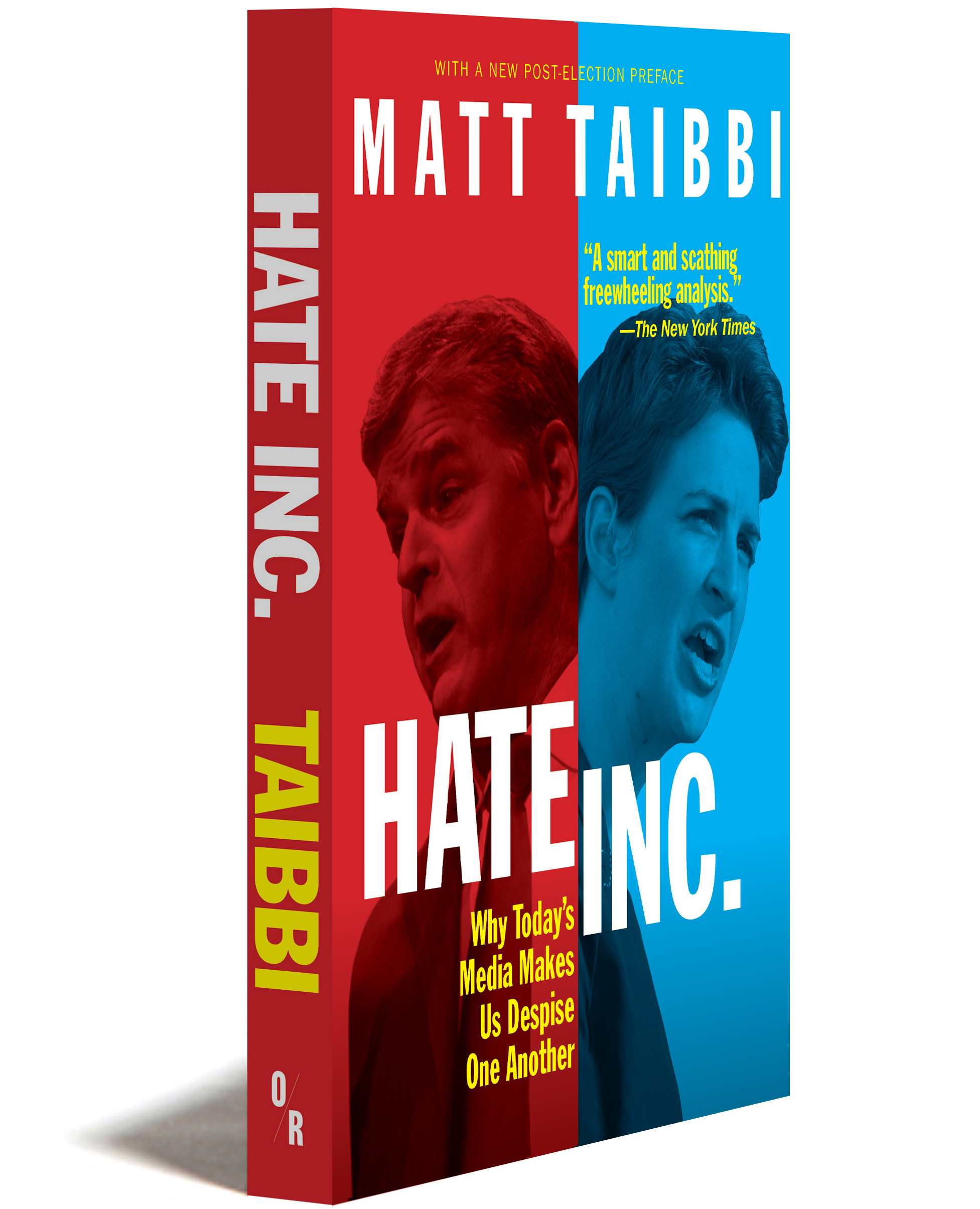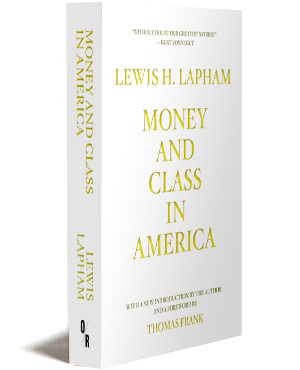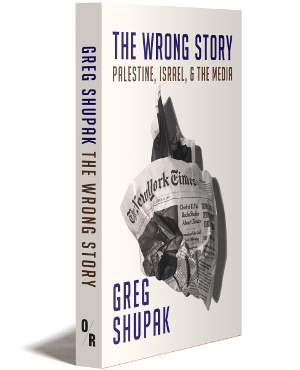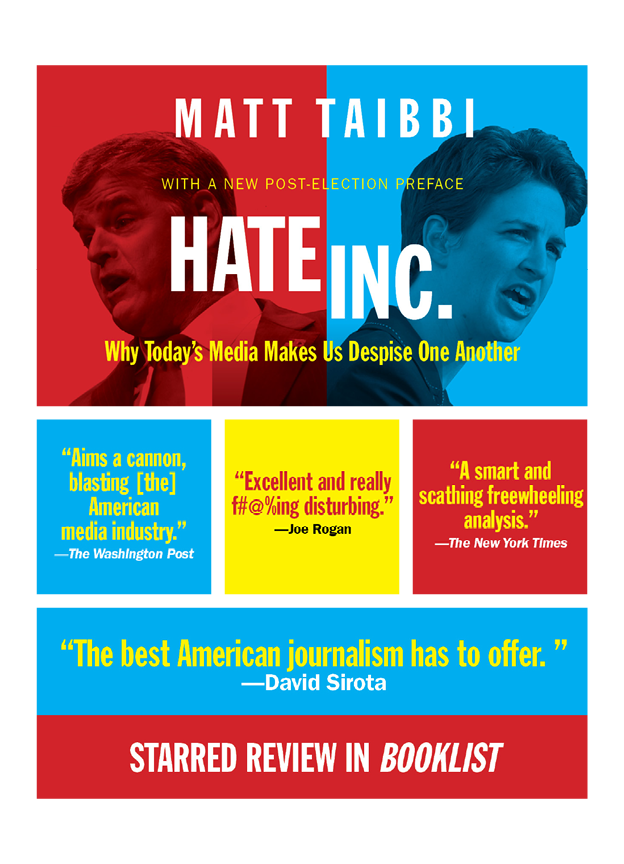
Hate Inc.
WHY TODAY'S MEDIA MAKES US DESPISE ONE ANOTHER
NOW IN A NEW EDITION WITH A POST-ELECTION PREFACE
“The best explanation of media behavior since Manufacturing Consent.” —Glenn Greenwald
“Fantastic... Everyone should read [it].” —Krystal Ball
“The best American journalism has to offer. ” —David Sirota
“Where other mainstream news sources fail, Matt Taibbi madly embraces his role as an honest political observer/writer/citizen in a democracy. ” —Janeane Garofalo
“Excellent.” —Joe Rogan
Starred review in Booklist
“An invigorating polemic against tactics the news media use to manipulate and divide their audiences.” —Kirkus Reviews
“Taibbi, a writer of striking intelligence and bold ideas, is as hilarious as he is scathing.” —Publishers Weekly
“In a smart and scathing freewheeling analysis, the Rolling Stone journalist analyzes political campaign coverage and other media powder kegs.” —The New York Times
“Taibbi aims a cannon, blasting [the] American media industry.” —The Washington Post
“Scathing and irreverent.” —The Los Angeles Review of Books
“A raucous updating of Noam Chomsky and Ed Herman’s classic dissection of capitalist news. Its message is hilarious yet grim: behind the buffoonery of the 24-hour partisan news machine is a propaganda system devoted to upholding the power of entrenched elites.” —Jacobin
“Brilliantly captures the current circus atmosphere and explores its roots in the political, economic and technological transformations of the last half century. ” —CounterPunch
“A bracing piece of media analysis… Should be required reading in all three remaining journalism schools. ” —Paste
TweetAbout the Book
In this characteristically turbocharged new book, now in a new post-election edition, celebrated Rolling Stone journalist Matt Taibbi provides an insider’s guide to the variety of ways today’s mainstream media tells us lies. Part tirade, part confessional, it reveals that what most people think of as “the news” is, in fact, a twisted wing of the entertainment business.
In the Internet age, the press have mastered the art of monetizing anger, paranoia, and distrust. Taibbi, who has spent much of his career covering elections in which this kind of manipulative activity is most egregious, provides a rich taxonomic survey of American political journalism’s dirty tricks.
After a 2020 election season that proved to be a Great Giza Pyramid Complex of invective and digital ugliness, Hate Inc. is an invaluable antidote to the hidden poisons dished up by those we rely on to tell us what is happening in the world.
320 pages • Paperback ISBN 978-1-68219-260-3 • E-book 978-1-68219-259-7
About the Author

Matt Taibbi is a contributing editor for Rolling Stone and winner of the 2008 National Magazine Award for columns and commentary. His most recent book is I Can’t Breathe: A Killing on Bay Street, about the infamous killing of Eric Garner by the New York City police. He’s also the author of the New York Times bestsellers Insane Clown President, The Divide, Griftopia, and The Great Derangement.
Read an Excerpt
FROM THE INTRODUCTION TO HATE INC.
Now more than ever, most journalists work for giant nihilistic corporations whose editorial decisions are skewed by a toxic mix of political and financial considerations. Unless you understand how those pressures work, it’s very difficult for a casual news consumer to gain an accurate picture of the world.
This book is intended as an insider’s guide to those distortions.
The technology underpinning the modern news business is sophisticated and works according to a two-step process. First, it creates content that reinforces your pre-existing opinions, and after analysis of your consumer habits, sends it to you.
Then it matches you to advertisers who have a product they’re trying to sell to your demographic. This is how companies like Facebook and Google make their money: telling advertisers where their likely customers are on the web.
The news, basically, is bait to lure you in to a pen where you can be sold sneakers or bath soaps or prostatitis cures or whatever else studies say people of your age, gender, race, class, and political bent tend to buy.
Imagine your Internet surfing habit as being like walking down a street. A man shouts: “Did you hear what those damned liberals did today? Come down this alley.”
You hate liberals, so you go down the alley. On your way to the story, there’s a storefront selling mart carts and gold investments (there’s a crash coming – this billionaire even says so!).
Maybe you buy the gold, maybe you don’t. But at the end of the alley, there’s a red-faced screamer telling a story that may even be true, about a college in Massachusetts where administrators took down a statue of John Adams because it made a Hispanic immigrant “uncomfortable.” Boy does that make you pissed!
They picked that story just for you to hear. It is like the parable of Kafka’s gatekeeper, guarding a door to the truth that was built just for you.
Across the street, down the MSNBC alley, there’s an opposite story, and set of storefronts, built specifically for someone else to hear.
People need to start understanding the news not as “the news,” but as just such an individualized consumer experience – anger just for you.
This is not reporting. It’s a marketing process designed to create rhetorical addictions and shut unhelpfully non-consumerist doors in your mind. This creates more than just pockets of political rancor. It creates masses of media consumers who’ve been trained to see in only one direction, as if they had been pulled through history on a railroad track, with heads fastened in blinders, looking only one way.
As it turns out, there is a utility in keeping us divided. As people, the more separate we are, the more politically impotent we become.
This is the second stage of the mass media deception originally described in Noam Chomsky and Edward S. Herman’s book Manufacturing Consent.
First, we’re taught to stay within certain bounds, intellectually. Then, we’re all herded into separate demographic pens, located along different patches of real estate on the spectrum of permissible thought.
Once safely captured, we’re trained to consume the news the way sports fans do. We root for our team, and hate all the rest.
Hatred is the partner of ignorance, and we in the media have become experts in selling both.
I looked back at thirty years of deceptive episodes – from Iraq to the financial crisis of 2008 to the 2016 election of Donald Trump – and found that we in the press have increasingly used intramural hatreds to obscure larger, more damning truths. Fake controversies of increasing absurdity have been deployed over and over to keep our audiences from seeing larger problems.
We manufactured fake dissent, to prevent real dissent.
In the Media
- “Matt Taibbi on the Depravity of the Media and Liberal Interventionists” — HATE INC. author interviewed on The Scott Horton Show (8/8/2022)
- “A terrific book… [Matt Taibbi] is one of the great writers of our time” — HATE INC. author Matt Taibbi interviewed on The Ryen Russillo Podcast (9/9/2021)
- HATE INC recommended by Matt Damon in the New York Times (7/29/2021)
- “Manufacturing dissent” — HATE INC author Matt Taibbi interviewed on Capitalisn’t (2/2/2021)
- UPCOMING WEBINAR: “How the News Became a Twisted Branch of Show Business—and What We Can Do About It” — with HATE INC. author Matt Taibbi (8/13/2020)
- “Return of the Vampire Squid” — HATE INC. author Matt Taibbi interviewed on Real Time with Bill Maher (5/4/2020)
- “A raucous updating of Noam Chomsky and Ed Herman’s classic dissection of capitalist news. Its message is hilarious yet grim: behind the buffoonery of the 24-hour partisan news machine is a propaganda system devoted to upholding the power of entrenched elites.” — HATE INC. reviewed in Jacobin (4/13/2020)
- “There’s a saying at The Nation magazine: what’s bad for the nation is good for The Nation. When the right is ascendant, in other words, so are subscriptions to the left-wing magazine.”—The Los Angeles Review of Books reviews Matt Taibbi’s HATE INC. (12/16/2019)
- “All the news media—with a few online exceptions—are part of a single poisonous and self-reinforcing information ecosystem.”—The New York Review of Books reviews Matt Taibbi’s HATE INC. (11/19/2019)
- Matt Taibbi discusses HATE INC. with Rania Khalek and Kevin Gosztola on Unauthorized Disclosure (10/22/2019)
- “Who split America? A journalist looks to his own for answers.”–The Washington Post reviews Matt Taibbi’s HATE INC. (10/18/2019)
- “Commercial media has always been sensationalistic. We were never not encouraged to aim content at your outrage center. We were always eyeball-hunting.”–HATE INC. by Matt Taibbi excerpted in A Public Seminar (10/15/2019)
- “In a smart and scathing freewheeling analysis, the Rolling Stone journalist analyzes political campaign coverage and other media powder kegs.”–The New York Times recommends Matt Taibbi’s HATE INC. (10/8/2019)
- Matt Taibbi goes on The Hill’s Rising to discuss HATE INC. (10/1/2019)
- “The question, especially for Americans old enough to remember Walter Cronkite and “the paper of record,” is what happened to journalistic objectivity and “fair and balanced” news. Why are major news outlets so partisan now?” —A Pressland review of HATE INC. (9/19/2019)
- “Reporters have often become unwitting props in the amped-up, WWE brand of politics practiced by Donald Trump, even as their organizations have profited mightily from it.” —A starred Booklist review of HATE INC. (8/29/2019)
- “A smart dissection of a grim media landscape.” —Publishers Weekly reviews HATE INC. (8/20/2019)
- “Hate Inc. brilliantly captures the current circus atmosphere and explores its roots in the political, economic and technological transformations of the last half century.”—John Kendall Williams reviews Hate Inc. in Counterpunch (8/2/2019)
- “An invigorating polemic against tactics the news media use to manipulate and divide their audiences.”—a review of HATE INC. in Kirkus Reviews (7/18/2019)
- “After generations of doing the opposite, when unity and conformity were more profitable, the primary product the news media now sells is division.” —Matt Taibbi, author of HATE INC., from an extract of the book published in THE WASHINGTON SPECTATOR (7/9/2019)
- “Like a con man who can lift a wallet in the middle of a melee, Trump thrived amid the chaos” —MATT TAIBBI, author of HATE INC. on Russiagate and Trump’s weaponizing of disarrayed media in Rolling Stone (4/5/2019)






